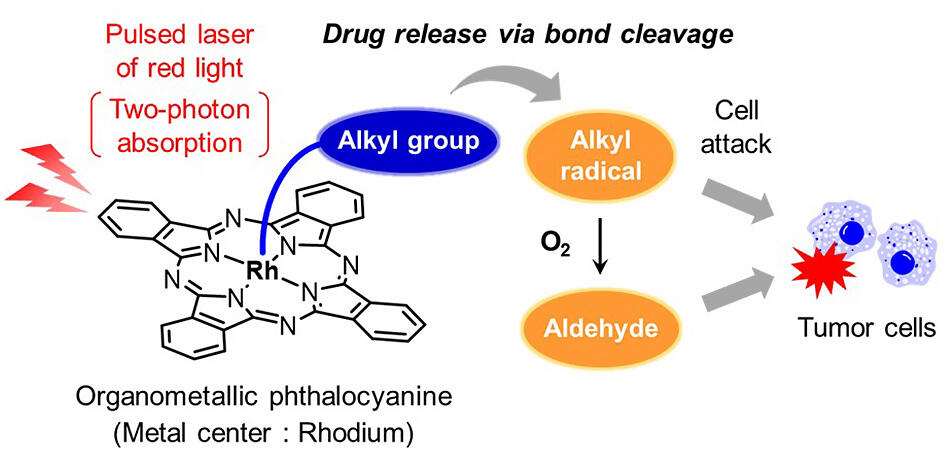Light cancer therapy (photodynamic therapy, PDT) is a method of activating substances using light energy and selectively treating tumors through their chemical reactions. Generally, it uses a mechanism of enzyme activation through light illumination, which leads to attacks on cancer cells. However, there were issues such as how it is difficult to induce apoptosis (programmed cell death), and there is a low therapeutic effect in hypoxic areas of tumor tissue. In a recent study, the research group of Research Associate Kei Murata, Professor Kazuyuki Ishii and Associate Professor Yoshiho Ikeuchi of the Institute of Industrial Science, the University of Tokyo, and their colleagues has suggested a new principle for a light cancer therapy method that can release drugs (highly reactive radicals and aldehydes, etc.) through red light (650 nm or more), which easily passes through the body.

Provided by the University of Tokyo
Light cancer therapy is a method of activating substances using light energy and selectively treating tumors through their chemical reactions. Generally, it uses a mechanism of enzyme activation through light illumination, which leads to attacks on cancer cells. The research group has suggested a new principle for a light cancer therapy method that can release drugs (highly reactive radicals and aldehydes, etc.) through red light, which easily passes through the body.
The group used phthalocyanine, which absorbs red light, as a new light-sensitive substance, developing an organic metal phthalocyanine (the metal used is rhodium (Rh)) that incorporates the organic metal complexes of the alkyl group. For the light source, they used a red nanosecond pulsed laser, with unique light that has an unusually strong peak intensity in an extremely short time (around 10-8 seconds).
The organic metal phthalocyanine is stable under ambient light, but when illuminated by the red nanosecond pulsed laser, the group found that it reacts with various biological molecules, and can release drugs such as alkyl radicals and aldehydes, which induce apoptosis.
After the organic metal phthalocyanine has absorbed two photons in an extremely short space of time (two-photon absorption), the metal-carbon bonds are cleaved and the reaction progresses. When the group investigated the toxicity of organic metal phthalocyanine in connection with HeLa cells, a human tumor cell line, it became clear that it demonstrated a cell-killing effect in specific concentrations via light illumination. The group also analyzed the cell death pattern, and showed that the light emissions of alkyl radicals/aldehydes contributed to cell death.
Research Associate Murata commented, "It is possible to introduce a variety of drugs using this system, so in addition to being used as a new light cancer therapy method, I hope that it can be developed as a drug delivery system too."
Journal Information
Publication: Chemical Communications
Title: Two-photon, red light uncaging of alkyl radicals from organorhodium(iii) phthalocyanine complexes
DOI: 10.1039/D2CC03672J
This article has been translated by JST with permission from The Science News Ltd.(https://sci-news.co.jp/). Unauthorized reproduction of the article and photographs is prohibited.




